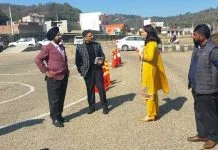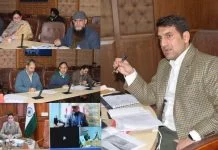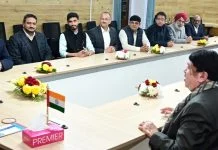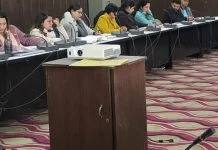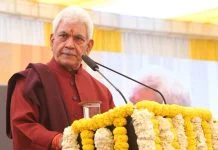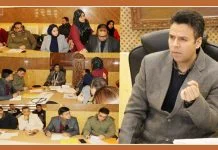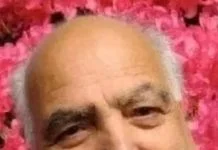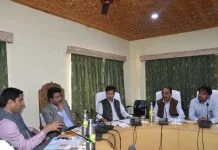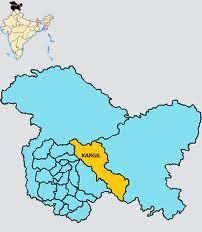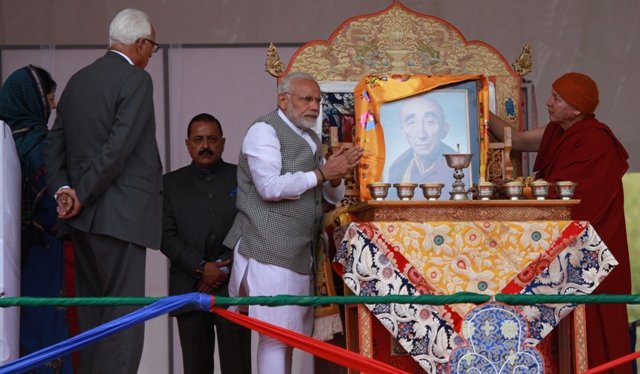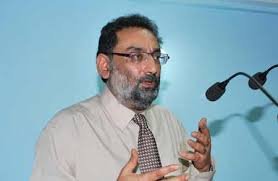Full text of the Budget speech.
Honorable Speaker,
- I rise to present the Annual Financial Statements relating to the Receipts and Expenditure for the current financial year.
- This budget, the first of this new PDP-BJP Government, has been formulated as a tribute to Jenab Mufti Mohammed Sayeed. Having had the privilege of being his Finance Minister, I have, in this budget, attempted to put into a framework the “Mufti Model of Governance”.
- As I understand it, it is the art and practice of politics and public service by combining personal integrity, political inclusivity and governance legitimacy. As such, these three themes are recurrent in the budget.
- First and foremost, drawing from his impeccable track record of six decades of personal integrity and honesty, an effort has been made in this budget to put in place systems and processes which will reduce and eventually eliminate corruption in our system and society.
- The second draws from his ideology of inclusivity. This budget will try to promote inclusivity across all sections and segments of our society, especially the marginalized and vulnerable; build a safety net and give a human face to Government without becoming a subsidy State.
- And, third drawing from his belief in democratic legitimacy of Government, an attempt has been made to restore the administrative will and institutional mechanisms for plugging the loopholes in enforcing regulations. In doing so, it is hoped that the State budget will become the most important tool for and of governance.
Budget Restructuring and Reforms:
- In my first Budget, I changed the entire classificatory framework of the budget. By abolishing the plan and the non-plan bifurcations, we moved to a revenue and capital accounting system. Being a systemic change, it is still a work in process. This year we have refined the classification further and hopefully the accounts are now a more accurate reflection of the reality in terms of developmental and non-developmental expenditures.
- I propose to make a few more changes to the accounting structure in the budget. These changes have been made with a view to cleaning up the accounts further and giving an actual picture of the state of affairs. First is the budgetary treatment of General Provident Fund. Since 1984, the State Government started the practice of debiting from the gross salary the required provident fund contribution of the employee and paying the net amount to the employee. Normally the amount deducted should have been earmarked and invested in long term financial instruments, so that the Government gets a return on the corpus to fund the interest it pays to employees. This was not done.
- Instead, the Government has been utilizing the net accruals on account of Provident Fund as captive resources to finance its day to day expenditure. To make matters worse, instead of accounting what it had borrowed from its employees, the net GPF was grossly understated in the budget
- so as to get a higher allocation of market borrowings. This fiscal hara-kiri has been committed year after year for the last 30 years or so.
- The net result of this incorrect budgetary practice has meant that the total liability on account of provident fund, which is completely un-provided for, is Rs. 14,058 crore as on March 31st, 2015. This is not all. The same procedure has been followed for State Life Insurance Scheme for Government employees for which the liability is another Rs. 588 crore.
- With no cash in the PF kitty, the outflows which get crystallized year after year, are being paid from current inflows. It is a classic version of what in financial circles is called a “Ponzi game”!
- The real threat of fiscal crisis, which I am raising now, should have been highlighted in 2009 when the New Pension Scheme was introduced in the State. For, post the NPS, the new inflows have stopped while the old outflows are continuing. Unless quick corrective action is taken now, in a few years, the State Government will not be in any financial position to pay back what it has borrowed from its own employees. I will leave it to this house to debate and decide whether it was a fraud perpetuated by earlier Governments or a primitive accounting error.
- Be that as it may, I want to assure all our employees that this Government will overhaul the PF accounting system, make provisions and address this issue at the RE stage. It needs a major, painstaking and a creative clean up. If need be we will put in place a line of credit to pay what is due to our employees. Let there not be any panic.
- Already we have improved the system. Not so long ago, the withdrawal of part or full GPF by our employees used to be a nightmare as their bills would remain pending in the treasuries for six to eight months. Today, and I am sure the employees will vouch for this, they are receiving their GPF dues within a day or so of their presentation of the bill.
- Second, relates to power sector accounting. Year after year, budgets have shown huge and mounting power losses emanating from the power sector. To address this issue, I have altered the entire power purchase and power receipts accounting system. I will explain this in the second part of my budget, the power budget.
- Third, relates to the treatment of wages of the DRWs, casual, seasonal, need based and other categories of workers. The significant reform that has been introduced is the treatment of wages. In many departments, especially after engagement of casual workers being banned in 1994, wages have been paid from O&M component of capital expenditure or from maintenance and repairs.
- There are three consequences of this; first, the wages are paid irregularly which is completely unethical. Second, is that it conceals the amount Government spends on wages. Third, it leaves no money for maintenance of our capital assets. We have now changed this system by insisting on paying wages from the head of accounts where it is to be paid from. As a result there has been an increase in our total revenue expenditure. Going forward, we will see some more increase as departments make this transition from concealing to revealing fully the wages that they actually pay.
- The result of this accounting irregularity has been that no one has been able to keep track of the ad hoc and casual recruitment in the Government till it has reached unmanageable proportions. To be honest, even if it may sound harsh, the short sightedness of our policymakers and ad hocism of our accountants has hurt our society through a “casualization” of our youth. It is no longer a financial problem. It is a social issue.
- Indeed, this is how the Government has approached, and declared its intent to find a solution to the issue of estimated 61,000 people engaged in various ways, in different forms and at different times. I am confident that with the guidance and support of the Hon’ble Chief Minister, we will be able to address it with empathy and understanding.
- Fourth, relates to the rather incestuous relation of PSUs with the State Government. Just two examples, will give you an idea of what is happening. The State Road Transport Corporation (SRTC), which is a on a budgetary support, is the exclusive transporting agency for CAPD. The Government, by virtue of an order gave SRTC a contract to carry food grains to various parts of the State for a mutually agreed price. The SRTC in turn sub-contracts it to private transporters with a commission/margin as high as 56 per cent. Whether this is poor contracting or inefficient pricing or plain corruption, I leave it to you to decide.
- Similarly, when the R&B department gives a contract for a road, it supplies bitumen procured from private players or cement procured from a State corporation. Not only is the price invariably higher than the market, it breeds and perpetuates inefficiencies and transactional corruption in the system. This system was created when commodities like cement, steel and bitumen were controlled commodities. That era is long over but the same system continues to survive, indeed thrive. A change is needed.
- It is imperative that procurement systems need to be made not only transparent but also market friendly. For instance, by permitting contractors to source their own key materials be it bitumen, cement or steel. Also, for all such departments, the civil accounting system has to be instituted.
- As a matter of policy and budgetary reform, I am happy to provide budgetary support to corporations wherever needed to cover their extra employment burden on the condition that they will compete for business, including Government business, in the open market. I assure the house that the efficiency gains of this will be much higher and will be shared across the system.
- The fifth and final budgetary reform is the reclassification and a liquidation plan of all existing liabilities. A major initiative to clear the power liabilities is underway. By the end of this year, we would have cleared all our power dues. I will give you details of the plan in the power budget.
Public Expenditure Management & Monitoring:
- The ever increasing liabilities of various kinds – authorized, unauthorized, departmental or at the treasury and the cost overruns are a major indicator of our poor system of expenditure management.
- In the last one month or so, institutional arrangements have been made and are being proposed to address the source of this malaise. First is the streamlining of cost estimates. At the moment, there are no standard specifications laid down for the infrastructure projects in the State. The estimated cost for building a Sub-District Hospital, for instance, ranges from Rs. 10 crore to Rs. 60 crore. The designs and drawings are governed by the availability of land rather than the public health standards. The interiors are determined by the stock available with contractors than by functionality and aesthetics.
- Be it the construction of roads, bridges, educational institutions, courts, office buildings there are hardly any norms and standards which are being followed. We have buildings taken up during the 1990s which are still incomplete.The five year plans are more of contractor’s plans than connectivity or developmental plans for delivery of public services. Frankly, in our system buildings and constructions have become an end in themselves.
- To lay down norms and guidelines for creation of public infrastructure and assets, the recently restructured Planning, Development and Monitoring Department shall review the system of preparation of cost-estimates through standardization of designs and other building specifications to bring about cost savings and efficiencies. This will be the start of normative public expenditure planning and will ensure the much needed administrative, financial and technical discipline. All these changes will ensure a matching of the cost estimates with the funding available and that in turn will improve project financing and also the overall financing of public infrastructure.
- The absence of norms is not true only of developmental expenditure. The system is no better in current expenditures where components like travelling expenses, office expenses, and establishment expenditure are allotted on incremental basis without any norms. For instance it has been noticed that the handling and carriage charges incurred on transportation of food grains to different points of sale in the State are not being carried out on a proper normative basis.
- It is imperative that there be proper tendering for determination of carriage charges to different locations of the State from current financial year, so that excess charging by the transporters is avoided in future, proper norms are in place and there is parity according to distance of the locations. In the course of this year, we will introduce normative budgeting which will bring a semblance of order and ensure judicious and efficient allocation and spending of public money.
- Civil Accounting in Forest and Engineering departments which was put in abeyance has already been made operative in respect of revenue expenditure. In the case of capital expenditure it will take effect from 1st April, 2017. Departments shall have to take necessary measures to shift to new system during the intervening period so that migration to new system is smooth.
- While systems are being tightened, it is also important that institutions are financially empowered. Towards this end, a significant decision aimed at granting financial autonomy to the State’s Universities to ensure efficient utilization of resources has been taken. Not only do the Universities now decide about the amount of tuition fees, they retain all internally generated resources. The Universities have also been given the freedom to generate and retain funding from sources other than the Government and to allocate it independently. The same principle of authority with accountability shall be followed with other autonomous bodies and institutions.
- In addition to a funding constraint, we also are often faced with a liquidity problem manifested in terms of unpaid bills at the treasury and the departments. While a part of it originates in the violation of systems mentioned above, some of it is due to inefficiencies in our management of public funds.
- For example a review of the cash and liquidity management systems revealed that over the years an abnormally large number of bank accounts have been opened by various departments of the Government. The number of Government accounts in J&K Bank alone is a staggering 2.31 lakh accounts. There will be a few thousands in other banks too!
- Amidst serious and severe shortage of liquidity, these accounts have been having a two year average balance of around Rs. 3,000 crore to Rs. 4,000 crore. This idle parking of funds shows lax control as these monies ought to have been transferred to the Government account as required under norms.
- We have initiated a process of consolidation and rationalization of all Government accounts so that this inefficient situation of unpaid salaries, contractor payments and other liabilities doesn’t coexist with bulging bank balances of a few departments! A system of leveraging financial resources is being put in place. This rationalization initiative will help the Government in improving the financial discipline as well as ensure better liquidity management.
- It may not be inappropriate to say that at times unethical behavior and petty corruption has been a consequence, undoubtedly an unintended one, of budgetary announcements. For instance, during one of the austerity drives, the big cut that Finance Department enforced was on tea served in offices. The tea never actually stopped but its financing changed! The tea that Hon’ble Ministers and officers had was paid, if whispers in the secretariat are to be believed, from faking printer cartridge bills! This to me sanctifies unethical behavior and breeds corruption at the lowest level and the system not only condones it but also internalizes it as acceptable behavior.
- Even as we speak, no police station, the primary interface with the citizens for resolution of law and order issues, has ever been provided any specific financial resources to meet the routine expenditure such as the cost of investigation of crimes. This includes basic things like petrol or stationary.
- The CAG has pointed out that during 2009-10 to 2013-14, allotment of fuel to district police stations for running their police vehicles was virtually non-existent. Such is the inefficiency of the system, that one third of the fuel quota was being consumed in to and fro journeys by vehicles from police stations to petrol pumps located at district headquarters. With this kind of a setup, the SHO has nowhere but to look for manna from heaven! This has often resulted in the perception of police station and its personnel being corrupt.
- This can be resolved and the system improved without much administrative effort and/or financial burden. By way of an example, I propose to do so by allocating Rs. 1 lakh each in favor of all the 193 Police Stations of the State as “Cost of Investigation”. Having the legitimate financial resource will certainly uplift the image of police stations in the minds of common masses.
- In the non-core activities of the Government, irrespective of our overall resources position, we must follow the global trends of alternate systems of delivery of developmental programs and public services. For a more effective delivery of public services, the State Government needs to lay stress on Public Private Partnerships. In our case, apart from improving the delivery of services, it will also help the nascent local private sector in its otherwise stunted growth. In key sectors with lumpy frontloaded investments, the Government will consider providing Viability Gap Funding so as to make it remunerative for the private partner.
BUDGET ESTIMATES FOR 2016-17
- This fiscal, the total receipts are estimated at Rs. 61,681 crore. Of these, Rs. 51,460 crore are revenues and Rs. 10,221 crore are in the form of borrowings. The State’s own revenues are estimated to be Rs. 23,739 crore while the share of Rs. 9,500 crore is the share of the State in central taxes. In addition to this, Rs. 27,721 crore are to flow as other central transfers.
- Given these receipts, the total expenditure is estimated to be Rs. 64,669 crore during 2016-17. Of this, capital expenditure would be Rs. 19,694 crore and revenue expenditure Rs. 44,975 crore. What these large numbers mean is that we are spending Rs. 2.50 in order to be able to spend Rs. 1.00 on development. To reduce this ratio from 2.5:1 and at least bring it at par with the development spend is the first big challenge. We have made a good beginning in this budget. But the road ahead is difficult as salaries and pensions alone account for more than Rs. 23,000 crore which is more than the total developmental expenditure in the year!
- The other challenge is to spend the budgeted money well. We are budgeting to spend about Rs. 180 crore a day. Apart from the much spoken about limited working season, our institutional capacity to spend is limited. Be it the time taken to do the documentation or tendering, or the installed and available capacity of the private sector the actual execution of works takes inordinately long to start and even longer to end.
- The total capital expenditure during the year is Rs. 19,694 crore, of which State capital expenditure is Rs. 4,362. While capital expenditure under centrally sponsored schemes is Rs 6,200 crore, the overall capital budget has got a leg up because of the additional resource allocation of Rs. 6,000 crore from the Prime Minister’s Development Plan (PMDP).
Relief and Rehabilitation
- The capital expenditure which forms a large part of the Prime Minister’s economic rehabilitation plan, has been designed as a critical link between relief and development. Underlying the plan is an intermediate strategy of institutional reform and reinforcement, of reconstruction and improvement of infrastructure and services initiating and supporting sustainable development.
- Even though PM’s plan has been formulated in the aftermath of the devastating flood of September 2014, in this plan, disasters have not been looked upon as singular events unrelated to development processes. The Prime Minister’s Development Plan (PMDP) is based on the understanding that relief, rehabilitation and development do not chronologically succeed each other but have to be simultaneous and are strongly interlinked.
- The size of the PMDP which is an aggregate of sectoral initiatives, is Rs. 80,000 crore. It is fully funded and expected to be executed over the next five years. The annual phasing of the plan will be based on the absorptive capacity and spending capability of the State Government and its implementing agencies.
- Under the PMDP, an amount of Rs. 1197 crore has been received for providing of assistance in respect of completely/severely and partially damaged houses. The release of funds has been provided to individual beneficiaries under the Direct Benefit Transfer mode through DDCs concerned. An amount of Rs. 957 crore has been disbursed till date.
- Financial assistance to certain category of uninsured and small traders affected by the floods, who had not received any assistance either from banks or other financial institutions, was provided assistance through the Chief Minister’s Flood Relief Fund. A total amount of Rs. 101.89 crore has been distributed till date among around 40,000 small traders whose turnover is up to Rs. 5.00 lac.
- The PMDP also included an amount of Rs. 800 crore for extending interest subvention support to the trading and manufacturing units whose borrowal accounts have been restructured by banks after the September, 2014 floods.
- These funds stand transferred by the Central Government. The interest subvention support will be provided through banks/financial institutions to the affected units very soon. The interest subvention scheme has been approved by the cabinet.
- For the displaced persons of PoK and Chamb, necessary scheme has been drawn up by the State Government and submitted to the Central Government for approval and release of financial assistance of Rs. 2,000 crore for its onward distribution among the identified 36,348 families. Cash Assistance to Jammu province migrants has been also recently enhanced and brought at par with Kashmiri migrants with effect from 18th November, 2015.
Industrial Policy Initiatives:
- There is a considerable uncertainty about the Industrial Policy in all the States that offer tax exemptions and other fiscal incentives to industry in view of the uncertainty about finalization of the GST. J&K is a little more complicated case as we have to carve out our space within the national tax regime while protecting our unique privilege of the right to tax services.
- Till such time as there is clarity on the implementation of GST and its applicability to the State, it will be difficult to formulate a long term Industrial Policy. However, prior to the formation of the new Government, an industrial policy for the State has been notified. This will require substantive changes once the GST regime is implemented. For the moment, few changes are required. Industrial associations of the State will be encouraged to develop, on their own or in partnership, private industrial estates/parks on commercial lines.
- While the Government will go all out to attract investments in industrial estates or elsewhere in the states by providing an enabling environment and incentives, it will be ensured that these are governed by and are in compliance of our existing administrative practices, regulatory norms and the Constitution of J&K.
- The industrial estates in the State, will be reorganized to function as a corporate entity within the aegis of SIDCO/SICOP. The idea is to make each one of them a profit centre. These estates shall become SPVs of the corporations or operating companies be it SIDCO or SICOP.
- In essence, the estates will effectively be corporatized and each estate will have an estates manager who will be the CEO of the industrial estate. All the unit holders within the estate will form its management committee. Each industrial estate will then have an income and expenditure statement and a balance sheet which will be audited annually.
- Further, one third of the earnings of the industrial estate by way of rents and other earnings shall be mandatorily deployed for the upkeep, maintenance and up gradation of the assets and infrastructure of the estates.
- Information Technology is an important sunrise industry in the State. To facilitate growth of this sector and to help the local IT companies reach certain economies of scale, the Government shall offer Joint Venture opportunity to State’s Top 10 IT companies in terms of audited top line. The State Government will invest through J&K E-Governance Agency (JAKEGA) or an SPV created for this purpose. The proposed initiative shall also help speed up e-governance projects in the State. For capitalization of the Joint Venture (JV), I have earmarked Rs. 10 crore.
- Our new breed of young entrepreneurs needs support for them to grow. Instead of giving them subsidies, I propose to set up Business Incubators for sunrise industries in the capital cities of Srinagar and Jammu. The Business Incubators will provide finances, branding, and marketing support to the entrepreneurs. To begin with, I propose a start-up fund of Rs. 5 crore.
Fiscal Initiatives:
- In the last one decade or so, no new industrial estate has been created in the State. To enable the Industries & Commerce Department to create a Land Bank across the State for acquisition and development of the new Industrial Estates, I am earmarking an amount of Rs. 40 crore.
- The Government is working out modalities to grant some specific relief to sick industries on account of arrears of power surcharge.
- In order to provide fillip to the local IT start-ups, I propose the following set of incentives:
- Waiver of permission fee for sanctioning “right of way” for laying optic fibre cables
- 50 per cent subsidy on bandwidth for connectivity to IT firms
- 50 per cent concession on Quality Certification and Patent filing charges.
- For artisans, an interest subvention scheme of the Government of India with a borrowing ceiling of Rs. 1.00 lakh recoverable in five years is in operation. The loan has so far been disbursed by J&K Bank in favor of 41,208 artisans. However, the 10 per cent interest subvention provision has not been provided for all these years. This has resulted in creation of a committed liability of Rs. 26 crore ending March, 2016. As a major relief for the artisans, I am making a one-time provision of Rs. 26 crore to clear this liability. It will pave the way for artisans getting renewed access to bank finance.
- The carpet industry is in the throes of an unprecedented crisis. While I will try to help the carpet industry through tax relief, for the weavers, I am providing the required funds for the additional 6000 improved looms which will cut the costs, and improve their productivity and incomes.
- The fabled handicrafts of Kashmir are facing a serious threat from cheap machine made imitations and counterfeits. This has seriously affected the livelihood of around 2.5 lakh artisans of the State associated with the regional crafts. In order to sustain and encourage the artisans of the State a serious effort is needed to create benchmarks for hall marking, certification and branding of Kashmir crafts. The Craft Development Institute has already started certification of genuine handmade pashmina. There is a need for pashmina testing, certification and labeling laboratory which can certify handmade products on a larger scale. This will not only fetch the producer more price, it will assure the buyer of what he is buying. I propose to provide Rs. 2 crore to these laboratories. Also, I will provide Rs. 50 lakh for a sustained promotional campaign to create mass awareness about certification and labeling of handmade Kashmir crafts.
- In 2004, the Government of India had announced a debt waiver scheme for houseboat owners. The Union Government released the required amount but it was diverted for other expenditures by the State Government. I propose to do a one-time settlement with J&K Bank and the State Bank of India for the total outstanding balance of Rs. 49.78 crore. This will give a major financial and emotional relief to all the houseboat owners and taxi drivers who have become defaulters with the Banks.
- Last year I had announced a 50 per cent waiver on KCC loans for those who had borrowed up to Rs. 1 lakh. The SLBC and individual banks have taken their own time to send us the certified borrowal accounts. I am happy to inform the house that we now have the required information and we shall soon provide relief to the farmers.
- In this budget, I have made adequate and necessary financial provisions to allow for the implementation of the “Free Drug Policy”, under which a number of drugs will be provided free of cost to the patients in the health centres of the State.
- At present the State does not have either a standard food testing laboratory or a drug testing laboratory. To set up one each at Srinagar and Jammu and to provide mobile testing facility for interior parts of the State, I am making an initial provision of Rs. 12 crore.
- The high density mission started in the horticulture has started picking up. In the next three years, you will see a transformation of not only the sector but also the way in which this business is being done. To supplement the ongoing activity in the farm, there is a need to plan ahead. In the course of replanting, the fruit growers need to be provided with trainings and skill development on training & pruning of trees, multiplication of rootstocks, raising of pedigree and quality planting materials, maintenance of bud banks, establishment and operation of drip irrigation system, nutritional management, protection from diseases and insects, pests, harvest management, grading, sorting, value addition, storage and market management. I am earmarking Rs. 1 crore for this purpose.
- The water resources of the State are presently being managed by various departments. While PHE Department looks after potable water, the Urban and Housing Development Department is responsible for management of lakes and waterways including the Dal Lake. The flood management is the responsibility of the Irrigation and Flood Control Department.
In order to bring synergy in the efforts of the State to fully harness and exploit its abundant water resources, I propose creation of a Water Resources Department which will be responsible for planning and management of all the water resources, including lakes and rivers, of the State. To set up the department, I am earmarking an amount of Rs. 2 crore.
- Our policemen work in very stressful and trying situations. On top of that they function in poor living conditions. The most serious aspect is the absence of adequate number of toilets in Police Lines and Police Stations. To ensure an adequate number of washrooms for policemen, it is proposed to allocate a sum of Rs. 2 crore for the purpose. More money will be provided based on the progress made in this regard.
- I propose to double the budgetary provision for the State Rehabilitation Council to enable it to provide increased support to the families of those affected by militancy.
- I have earlier mentioned that the Government will support the power sector through targeted subsidy schemes aimed at supporting the poor and marginal consumers. I propose to provide upto 30 units of free power and waiver of fixed charges in favor of all metered BPL domestic consumers. However this subsidy will be made available from 1stJanuary, 2017 by which time State Government would have consolidated, verified and authenticated the Aadhaar linked list of BPL consumers in the State.
- For last 26 years, journalists working in strife torn State of Jammu and Kashmir are facing hardship as there is no welfare scheme for scribes. I propose to set up a Journalist Welfare Fund with an initial corpus money of Rs. 2 crore for the welfare of working and accredited journalists of the State. In the event of untimely death of a working or accredited journalist or in case a journalist is rendered incapacitated, his wife or legal heir or dependents will get assistance from this Fund. It would be ideal if the journalists of the State get together and set up a society, frame the rules and guidelines for administering this fund.
- To preserve the cultural heritage of the State, I propose to set up a Heritage Conservation Fund for heritage buildings in the State. Out of the 800 heritage structures listed, I intend to take up, in the first year, 50 listed structures and fund the conservation and restoration work of these structures. For this I am earmarking Rs. 5 crore this year.
- Within a day of the Government being formed, a number of employee welfare measures were announced. These include, release of pending DA installment of 6 per cent from July 2015 and substantial enhancement in the rates of Durbar Move and Temporary Move Allowances. The Government also announced increased pensionery benefit for those who had crossed the age of 80 years. In the same spirit, I announce the release of pending DA installment of 6 per cent in favor of Government employees from 1st January 2016.
- While I am happy to be able to release the dues of employees in time, I must share with this house that I have not been able to make provisions for the implementation of the impending Seventh Pay Commission Award. The existing resource position of the State Government doesn’t permit me to do so. Also, what is staring us in the face is the possibility of having to make provisions for the estimated 61,000 casual and other workers.
- Successive Governments have implemented the recommendations of the previous Pay Commissions much to the detriment of the financial health of the State. Not that I will have any options. But I would urge this House to debate the need and desirability of implementing the Seventh Pay Commission award with all its ramifications including the squeezing out of developmental expenditure. I would urge the stakeholders, including the employees, to think not only as Government employees but as citizens as well about the larger implication of accepting the Seventh Commission awards. It should be a conscious decision by consensus.
TAX PROPOSALS:
- In the last budget I had expressed my discomfort with the concept of “negative lists”. In an era of liberalization, these are anachronisms of the control raj and we must do away with these. I will be very happy to consider doing away with the negative list if I get a collective commitment and assurance from the trade and business fraternity that they will act in enlightened self-interest and not misuse it for pecuniary gains at the cost of the State and the society at large. For the moment, the list has been made simpler and categorized into groups.
- My tax proposals are of three kinds:
First, extending some of the existing exemptions that have been given to industry, trade, tourism and commerce for a further period of one year. I believe that our economy has not yet come out of the woods even though one can see some signs of a recovery. To help this nascent turnaround, I propose to extend the following till March 31st, 2017;
- Exemption on essential commodities which are listed.
- Remission to the local industry from payment of Value Added Tax.
- Exemption on Central Sales Tax to industrial units.
- Exemption from Toll on raw material and finished products of industrial units.
- Exemption to lodging services provided by Hotels, Lodges and Guest Houses.
- Second, I am introducing a few new tax exemptions for those industries/sectors that are in the throes of a crisis. These include carpets and agriculture. For the benefit of these sectors, I propose:
- All types of Cotton and Silk Yarn, whether it is in hanks and otherwise, be placed in the zero rated tax category.
- All kinds of local handmade and handloom carpets be placed in zero rated tax category.
- Exemption from levy of VAT for agricultural implements like threshers, tillers and harvesters.
- Tax exemption on plant growth promoters and regulators.
- Tax exemption on Rodenticides and herbicides.
- Third, is the category of new exemptions for promoting overall well being – health, entertainment, environment- of our people. These include:
- Exempting all services rendered by the health clubs, gymnasiums, fitness, wellness centres, slimming centres from the levy of tax.
- Exempting all medical services provided by the hospitals and nursing homes from tax thereby making private healthcare affordable.
- Reducing the rate of VAT on medical imaging equipments, X-ray machines, scanners, X-ray films and plates from 13.5 per cent to 5 per cent tax rate category.
- Exempting handmade cups, plates made of leaves and papers from VAT.
- Bringing LED lights, lamps and tubes under zero rated tax category.
- Fourth, is the category of tax changes which are proposed for simplification, administrative convenience or have been specifically sought by the local industry and trade bodies on the grounds that similar commodities must be taxed at a uniform tax rate. The following changes have been proposed:
- All kinds of fresh and cooked food sold by hotels/ restaurants/eateries/dhabas shall be in the category of 5 per cent tax.
- Exempting EOT cranes, forklifts, pallet trucks, chain blocks used for material handling by such industrial units from payment of Entry Tax.
- Automobiles sold by CSD canteens to members of the Armed Forces having Canteen Smart Cards to be placed in the category of 5 per cent rate of tax instead of 13.5 per cent.
- All capital goods namely machinery and allied goods are specifically mentioned in Schedule D-1. It is thus proposed that the words capital goods listed in 5 per cent tax schedule be deleted to avoid misinterpretation and misclassification.
- With a view to check the misuse of concession available to the industries and to protect the local trader, negative list annexed to SRO 91 is proposed to be extended and the following activities be brought under the ambit of negative list (i) Hot Mix Plants (ii) Cutting and grinding of glass; itching, silvering bevelling, frosting and designing of glass.
- VAT on containers to be reduced from 13.5 per cent to 5 per cent.
- VAT on utensils made of precious metals to be reduced from 13.5 per cent to 5 per cent.
- Paneer and Cottage Cheese when sold in packed form is proposed to be taxed at the rate of 5 per cent since these products are manufactured and sold in the market in the branded form by the manufacturers. This measure will promote the sale of locally made cottage cheese/paneer.
- Lassi, Butter Milk, Separated Milk and Flavoured Milk when sold in packed form is proposed to be placed under schedule D-1 of J&K VAT Act, 2005.
- VAT on the parts of bicycles, tricycles & tyres and tubes of cycle rickshaws is proposed to be reduced from 13.5 per cent to 5 per cent.
- Shawls, Stoles and Towels are proposed to be classified under 5 per cent tax rate category specifically.
- Toddy, Neera and Arak falling in entry No.43 of Schedule-A are proposed to be deleted from zero rated category being intoxicating drinks.
- Dhupkathi and Dhupbati presently taxed at the rate of 5 per cent are proposed to be exempted.
- At present, there is conditional exemption on Misri, Batasa, Makhana and Phullian. To promote the sale of these goods of local importance, the associated conditions are proposed to be removed to exempt this commodity categorically from levy of VAT.
- Bangles made of imitation gold are proposed to be placed in Schedule D-1 to bring the same at par with other imitation jewellery.
- The words “Plastic footwear” are proposed to be deleted in view of already existing entry “moulded plastic footwear, hawai chappals & straps thereof” listed in the same rate schedule of 5 per cent.
- Chilly seeds which are used as spice are not listed in any schedule. It is proposed that chilly seeds be made part of “spices” listed in the 5 per cent tax schedule to avoid misclassification.
- Hose pipes and fittings are proposed to be deleted from 5 per cent rate category as another similar entry “pipes of all varieties” exists in Schedule D-1.
- The term PVC listed in 5 per cent rate schedule is renamed as polyvinylchloride to avoid misinterpretation.
- Insulators are widely used in the Transmission & Distribution lines, thus they form part of entry “electrical goods of all kinds used in the generation, transmission, distribution or in connection with the consumption of electricity” mentioned in Schedule D-1. It is proposed that the word “Insulators” be deleted from 5 per cent tax schedule to avoid contrary interpretation.
- The items namely, “Napaslabs and Shahbad Stones” are proposed to be deleted from 5 per cent tax schedule in view of similar entry listed in Schedule D-1.
- The word ‘edible’ is proposed to be added before the word ‘starch’ in order to stop misuse of laundry starch which is taxable in Schedule – D.
- Transformers falling under Schedule C are proposed to be placed in the Schedule D-1 where other Electric and Electronic goods are placed.
- Room fresheners, Air fresheners and Naphthalene balls are proposed to be included in Schedule D1 to avoid misclassification.
- Rusks of all kinds are proposed to be included in Schedule D-1 as all other bakery products have been kept there.
- Multi Functional Devices and Printers are proposed to be included in Schedule D-1 in order to avoid misclassification.
- The words ‘in liquid, pill, powder form’ of entry No.156 of Schedule D-1 is proposed to be replaced with words ‘in any form’ to avoid misclassification.
- Fifth and final are some increases in the tax rates. Since 2010, the rate of VAT has not been revisited as has been done by a large number of States. With a view to mobilize additional resources, the following changes are proposed:
- Tax rate levied on the items listed in the Schedule D-1 is proposed to be enhanced from 13.5 per cent to 14.5 per cent.
- Further, Schedule D-1 is proposed to be expanded by including cell phones, mobile phones, Tablets, I-Pads and their accessories, imitation jewellery, readymade garments and hosiery goods and all types of packed, frozen food, juices ready to serve foods. The details of these small changes will be notified by the Commercial Taxes Department.
- Enhance the tax rate on Aviation Turbine Fuel under J&K GST Act, 1962 from 20 per cent to 25 per cent.
- The basic toll levied on vehicles has not been revised since 2007. Similarly, there is also a need to further enhance the rate of toll on goods to generate additional revenue. Accordingly, an increase between 8 to 15 per cent over the prevailing rates is proposed in this sector.
- Levy entertainment duty of Rs. 50 per connection per month on satellite and cable TV operators.
- The online purchases by the consumers are increasing day by day and the practice to purchase goods and services by splitting the value into bills of less than Rs. 5000, which is presently the threshold limit for levy of entry tax, is rampant. This puts the local retailers to disadvantage as the same goods & services sold by them are costlier being loaded with tax. To put the local dealers on an equal footing, it is proposed that the threshold limit of Rs. 5000 be done away.
- The services provided by Chartered Accountants and Cost and Works Accountants in the shape of Accounting & Auditing Services are taxable under J&K GST Act, 1962 once their turnover exceeds Rs. 5 lakh. Since large number of professionals are providing such services and generating ancillary employments, I propose to enhance the threshold limit in case of the said services from Rs. 5 lakh to Rs. 10 lakh.
- Grant of amnesty for waiver of Interest and penalty is a long pending demand of traders, industrialist and transporters which could not be addressed due to interim orders passed by the Hon’ble High court in a Public Interest Litigation. The Hon’ble High Court has recently modified its order and allowed the Government to grant waiver from payment of penalty subject to payment of principal tax and interest. To offer relief to these sectors, I propose to grant amnesty to the dealers from payment of penalty under the J&K GST Act, 1962 subject to payment of principal tax along with the interest due. I also propose to envisage a scheme to waive off the penalty levied on transporters under Section 15-A (8)(b) of J&K GST Act, 1962 up to the financial year 2004-05.
- Finally, in deference to our first woman Chief Minister, I am introducing some gender specific budgeting initiatives! I propose that Government waive off the fee of all girl students in the State Government run Educational Institutions up to the higher secondary level.
- I propose that 10 per cent area in all industrial estates of the State shall be reserved for women entrepreneurs subject to the condition that if it is transferred it shall be to an enterprise which is incorporated in the name of a woman and has women as the majority shareholders as directors. The Industries & Commerce Department will notify these additions.
- I am proposing to set up two Entrepreneur Development Centres, to be set up at Srinagar and Jammu to help, guide, and train aspiring women entrepreneurs.
- I am announcing the setting up of four more women police stations in the State. The districts where these will be set up are Pulwama, Kupwara, Kathua and Udhampur. This is in addition to the four women police stations being set up on the directions of the Hon’ble Chief Minister at Anantnag, Baramulla, Jammu and Rajouri.
- I am earmarking an additional amount of Rs. 5 crore for a dedicated city bus service for women in Srinagar and Jammu cities.
- I am making a provision to provide exclusive women toilets in all the state, district and sub district hospitals.


